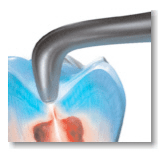 Ever wonder how dentists know whether there is a cavity in a tooth? We use x-rays to look for cavities in-between teeth, but how does a dentist know if there’s decay in the grooves of your teeth? In the past, the dental profession has traditionally used a dental explorer to feel for soft spots in the grooves of teeth. Unfortunately, there was often some guesswork involved. Before fluoride was added to our community water supplies to help prevent cavities, decay would often be a large hole and easy to spot. Since fluoride has been used, dental decay in the grooves of teeth now is very narrow and more difficult to diagnose. A newer technology that is now available in our office is a laser device called a Diagnodent. This device shines a laser light into the grooves of your tooth, and a numeric value is displayed that indicates how much decay is present. It’s completely painless, and even very small cavities can be detected at their earliest stage, so that decay can be caught before more tooth structure is damaged. Cavities can start in the grooves of teeth even before a child’s tooth fully appears. In almost 90% of molar teeth, the grooves aren’t formed completely. A dental sealant can be placed soon after the tooth erupts to protect these incompletely formed grooves in the teeth from developing cavities.  In our office, we use the Diagnodent laser to tell us if a sealant can be used. When the Diagnodent’s digital reading displays a reading of 23 or higher, we know there is an actual cavity present that requires a filling. For a reading of 22 or less, we can place a sealant to keep the tooth from getting a cavity in the first place. For more information on the Diagnodent, or to schedule your next appointment, contact us today.
1 Comment
Leave a Reply. |
Articles
All
AuthorDr. Moorhead and his team write about dental news, and answer patient questions. Archives |

 RSS Feed
RSS Feed